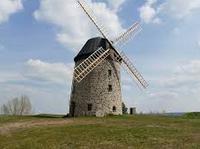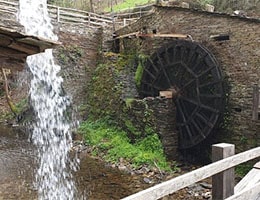 With etymological origin in the late Latin word molīnum , a mill is a machine used for grinding . Its operation is based on the movement generated by wind, water or other driving force.
With etymological origin in the late Latin word molīnum , a mill is a machine used for grinding . Its operation is based on the movement generated by wind, water or other driving force.
Mills, therefore, are devices used to grind : that is, to convert a body into powder or squeeze it. The first mills arose in Prehistory and were operated manually.
Tubers, seeds y cereals pueden molerse con un molino, que dispone de los elementos y los mecanismos necesarios para cumplir con su function. Aunque existen diferentes tipos de molinos, a nivel general puede decirse que cuentan con una sill (una piedra fija) sobre la cual se desplaza la molar (otro disco de piedra, pero más pequeño). Aquello que se desea moler se coloca entre solera y la muela y luego se hace girar la muela con rapidez.
To give movement to the molars, water ( water or hydraulic mill), wind ( windmill ) or even the force generated by animals ( blood mill ) was usually used. Smaller mills or grinders , meanwhile, can be activated by hand , as in the case of some home devices used to grind coffee.
Nowadays there are also mills with motors that, using chemical energy (combustion) or electrical energy , produce the movement required to achieve grinding.
Regarding the history of mills, we know that the first were manual and their application was the grinding of various types of tubers. In the Neolithic, the second and last period of the Stone Age, its use was especially widespread, since the economy focused on agriculture. Although at that time the seeds that workers collected, such as chestnuts and acorns, cereals and grasses became the most important products.
The development of wheat, that is, wild or cultivated cereals, took place approximately between the 10th and 8th centuries BC. C., in the Near East and Anatolia. It is believed that the grinding of wheat for the production of flour began using mortars and pestles, or using two flat rocks to crush it. And it is precisely this last method, of precarious appearance, that probably led to the creation of blood traction mills, which are mentioned in very ancient documents.
 One of the lesser-known types of mill is the floating mill , which is also known as a boat mill , ship mill , or boat mill . It is a hydraulic mill, that is, it uses the power of tidal or river water, and is made up of a mill wheel that is placed on the side of one or two boats so that the currents make it rotate.
One of the lesser-known types of mill is the floating mill , which is also known as a boat mill , ship mill , or boat mill . It is a hydraulic mill, that is, it uses the power of tidal or river water, and is made up of a mill wheel that is placed on the side of one or two boats so that the currents make it rotate.
Its creation took place in Italy, in the middle of the 6th century and is mentioned in the Encyclopédie Diderot , published in 1751. Towards the end of the 19th century its use became less and less popular; However, it was only in the 20th century that they completely disappeared.
The ram mill , on the other hand, is not used to grind but to crush the material in the field of mining. It is also known as a pylon battery and is used to process and extract metallic minerals. It consists of a group of steel tampers supported by a frame, which move cyclically up and down.
Molino , finally, is a term that appears in surnames ( Francesco Molino , Sergio del Molino ) and places ( Molino de la Hoz , Molino de Escartín ).
